Backyard Wasp Repellent: Smart Strategies for Control
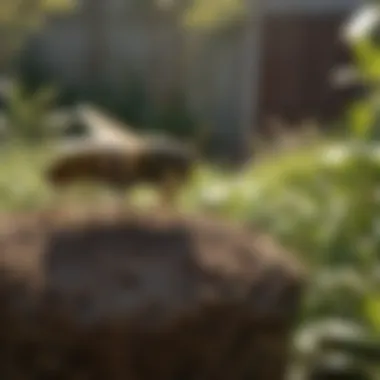

Intro
Wasps can be a nuisance in backyard spaces, especially during the warmer months. Their presence can transform a peaceful outdoor gathering into a worrying situation. Understanding how to manage wasp populations effectively is essential for creating a safe and enjoyable environment at home. This article provides insights into practical methods for repelling wasps, incorporating both natural and chemical strategies. Homeowners will benefit from learning about wasp behaviors, effective prevention techniques, and sustainable practices that are eco-friendly.
Understanding the Pest
To effectively manage wasps, it is crucial to comprehend their nature and habits. Knowledge of wasp identification and their life cycle can play a vital role in prevention and control strategies.
Identification
Wasps come in many species, but common types include yellow jackets and paper wasps. Yellow jackets are often mistaken for bees due to their similar appearance, but they exhibit distinct features, such as a more slender body and smooth skin. In contrast, paper wasps have longer legs and a more elongated body. Identifying these creatures is the first step toward effective management.
Life Cycle
Wasp life cycles typically consist of four stages: egg, larva, pupa, and adult. In early spring, fertilized queens emerge to establish new colonies. They can lay thousands of eggs, which quickly develop into new workers. Understanding this cycle aids in determining the best times for intervention and prevention. Quick action during the early stages of wasp population growth can significantly reduce their presence later in the season.
Pest Prevention Strategies
Effective management of wasps starts with prevention. Taking proactive measures can diminish the likelihood of wasps establishing nests in your backyard.
Environment Modification
Adjusting the backyard environment can effectively deter wasps. It is essential to eliminate food sources and shelter. This includes:
- Keeping garbage bins covered and clean.
- Removing fallen fruit from trees.
- Cleaning outdoor grills and areas where food is prepared or consumed.
- Sealing entry points to attics and sheds,
This approach does not kill wasps but makes the area less appealing to them.
Physical Barriers
Physical barriers serve as another vital strategy in preventing wasp incursions. Installing wasp traps can reduce the number of wasps entering an area. Using mesh screens on doors and windows also helps keep them out of living spaces. Additionally, strategic placement of decoy nests can deter wasps, as they prefer to avoid establishing themselves near active nests.
Control Methods
When prevention fails or a wasp invasion occurs, control methods must be implemented. It's important to approach this carefully to ensure safety.
Chemical Control
If a significant wasp presence is detected, chemical control options exist. However, caution is needed to avoid harming beneficial insects. Products such as insecticidal sprays can be effective when used according to the manufacturer's instructions. Applying chemicals in the early morning or late evening when wasp activity is low can prevent accidental encounters.
Biological Control
Consider biological control as a sustainable alternative to chemical methods. This includes encouraging natural predators like birds, who can help manage wasp populations. Additionally, traps designed to attract and capture wasps can reduce their numbers without resorting to harmful chemicals.
Employing both preventive strategies and control methods strategically can create a balanced approach to wasp management in your backyard.
Understanding Wasps
Understanding wasps is crucial for effective backyard management. Wasps play a significant role in ecosystems, contributing to pollination and controlling pest populations. However, their presence can become a concern, especially in residential areas. The more one knows about wasps, the better one can manage them safely and effectively.
Biology of Wasps
Wasps belong to the order Hymenoptera, which also includes bees and ants. They have a distinct body structure, characterized by a narrow waist and two pairs of wings. Most wasps are social and live in colonies, although some are solitary. They are known for their stingers, which they use for defense and subduing prey.
Wasps have a complex life cycle, transitioning through egg, larva, pupa, and adult stages. The queen usually lays eggs in spring, and workers tend to the hive. Understanding their biology helps in anticipating their lifecycle phases, therefore aiding in control measures.
Behavioral Patterns
Wasp behavior can vary greatly depending on the species. Generally, they tend to be more aggressive during late summer and fall, particularly when their food sources become scarce. During this period, wasps are more likely to invade human spaces in search for sweeter foods, like fruits and sugary drinks.
Additionally, wasps exhibit specific scouting behaviors. They send out foragers to find potential food sources, which can lead to increased sightings around homes. Recognizing these patterns allows homeowners to implement preventive actions effectively.
Types of Wasps Commonly Found
There are many types of wasps, each with unique characteristics and behaviors. Three common types that homeowners might encounter include:
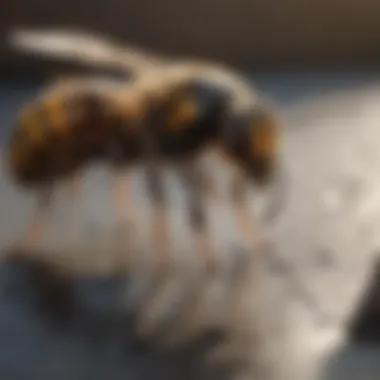
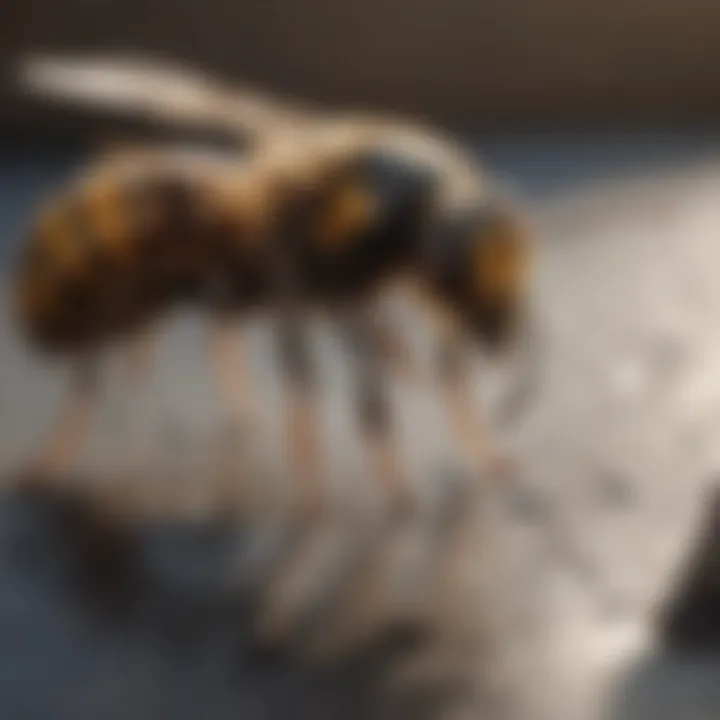
- Yellowjackets: Known for their black and yellow stripes, yellowjackets are aggressive and often build nests in the ground or in wall cavities.
- Paper Wasps: These wasps create umbrella-shaped nests made from chewed wood fibers mixed with saliva. They are less aggressive but can defend their nests if threatened.
- Bald-Faced Hornets: Despite their name, they are not true hornets. They are capable of stinging multiple times and usually nest in trees or shrubs.
Understanding these types allows homeowners to identify threats and apply appropriate management techniques.
The Necessity of Wasp Management
Effective wasp management is essential for several reasons. Wasps are not just annoying; they can also pose significant threats to safety and comfort in recreational spaces like backyards. Understanding the necessity of managing wasps helps homeowners mitigate risks and create a safe outdoor environment. Without proper management, homeowners might experience increased instances of stings, which can lead to allergic reactions. Some individuals are severely allergic and require immediate medical attention if stung.
Besides personal safety, wasp infestations can cause property damage. Nests located in or near homes can lead to structural issues over time. This might require costly repairs for homeowners if infestations are not controlled. Therefore, taking a proactive approach to wasp management is not just wise but necessary.
Moreover, managing wasps contributes to a more enjoyable outdoor experience. Many families enjoy barbecues, gardening, or relaxing in their yards. However, an underlying fear of wasps can hinder these activities. By employing effective strategies to repel wasps, homeowners can reclaim their outdoor spaces and enhance their quality of life.
In summary, the necessity of wasp management revolves around safety, property protection, and overall enjoyment of outdoor living spaces. Ignoring the issue can lead to severe consequences, both physically and financially. Therefore, it is crucial to understand how to manage wasps effectively.
Potential Risks of Wasp Infestation
Wasp infestations pose various risks that can significantly impact both individuals and property. Firstly, wasps can be aggressive, especially if their nests are disturbed. Stings from wasps can be painful and, in some cases, lead to serious medical emergencies. For those with wasp allergies, even a single sting can trigger anaphylaxis, a life-threatening reaction. This risk makes it paramount for homeowners to address wasp presence in their backyards promptly.
Additionally, wasps can become a nuisance during outdoor gatherings. Their attraction to food and sweet beverages can be both irritating and alarming for guests. This behavior can lead to a disrupted social environment, causing discomfort for those unaccustomed to their presence. Thus, managing wasp populations becomes essential to ensure comfort and safety during family events.
There are also broader implications to consider. Wasps are predators of other insects and play a role in the ecosystem. However, when they invade human spaces, their presence can lead to a reduction in biodiversity in local gardens. Homeowners who cultivate plants may notice declining health in their gardens due to competitive feeding habits or destructive nest-building behavior.
Overall, the potential risks associated with wasp infestation justify the need for effective management strategies. Homeowners should be aware of these risks and act quickly to prevent infestations from causing harm.
Environmental Impact Considerations
When addressing wasp management, it is crucial to consider the environmental impacts of various strategies. While the aim is to reduce wasp populations, many methods can affect local ecosystems. Chemical solutions, while effective, often have unintended consequences that can harm beneficial insects, such as bees, butterflies, and other pollinators that share the environment with wasps.
Furthermore, habitat destruction is another concern. Some methods of wasp control involve removing trees or shrubs where nests might be built. This can lead to a loss of biodiversity and negatively affect other wildlife. Homeowners should consider balancing their needs for safety and comfort with ecological sustainability.
Natural methods, such as utilizing essential oils or setting up traps, provide alternatives that often have lesser environmental impacts. Implementing these strategies can effectively manage wasp populations while minimizing harm to the broader ecosystem. Awareness of these considerations should guide homeowners in selecting the most suitable and sustainable wasp management techniques for their properties.
The balance between effective wasp control and environmental stewardship is essential for sustainable management. Choose methods that protect both safety and nature.
Identifying Wasp Nests
Identifying wasp nests is crucial for effective management. Knowing how to detect these nests can help homeowners take preventive actions early. Furthermore, it provides insights into wasp behavior, allowing for tailored control measures. Understanding the locations and signs of activity are fundamental to minimizing interactions with these insects.
Signs of Wasp Activity
Recognizing the signs of wasp activity can prevent a potentially dangerous situation. Common indicators include:
- Increased Wasp Sightings: Frequent sightings, especially in late summer or early fall, suggest that there may be a nest nearby.
- Loud Buzzing Sounds: A distinct buzzing noise around certain areas can indicate a nest’s presence.
- Visible Nest Construction: During warmer months, wasps often build nests from paper-like material. Keep an eye out for these structures, especially high up in trees or under eaves.
- Food Gathering: Wasps are attracted to food sources, especially sugary items. If you notice wasps frequenting outdoor dining areas or trash bins, a nest could be close.
Being vigilant about these signs allows you to assess and act before a larger infestation arises.
Common Nest Locations
Wasps tend to build nests in specific locations that can be problematic. Familiarity with these sites can inform your approach to wasp management. Common nest locations include:
- Under Eaves and Roof Overhangs: These shaded spots offer protection and warmth, making them ideal for nests.
- In Wall Cavities: Wasps may enter through cracks or holes in buildings to create nests in wall voids.
- Tree Branches: Hanging nests can often be found in deciduous trees, providing a good shelter from predators.
- Underground: Some wasp species construct nests below ground, particularly in sandy or loose soil.
Identifying these locations early can be essential for implementing effective prevention or control strategies.
Preventative Measures for Wasp Control
Preventative measures play a critical role in managing wasp populations in backyard environments. By understanding and implementing effective strategies, homeowners can discourage wasps from establishing their presence. This not only reduces the likelihood of stings but also helps in maintaining a pleasant outdoor setting.
Habitat Modification
Habitat modification involves changing your backyard to make it less appealing to wasps. Wasps prefer areas that offer shelter and food supply. Therefore, consider the following strategies:
- Remove or relocate nesting sites: Wasps often build nests in sheltered areas like eaves, attics, or dense shrubbery. Regularly inspect your yard and carefully remove any existing nests during late fall or winter when the wasps are less active.
- Trim trees and shrubs: Keeping greenery well-trimmed can limit wasp nesting opportunities. Reduce overgrown vegetation where they might find hiding spots, especially near picnic areas or outdoor dining spaces.
- Create open spaces: Open areas are less inviting to wasps. Maintain clear zones in your yard where there are fewer obstacles and hiding spots for them.
Though habitat modification can significantly reduce the risk of wasp infestation, it requires ongoing attention. Regular monitoring of your yard’s environment will ensure it remains less hospitable for wasps.
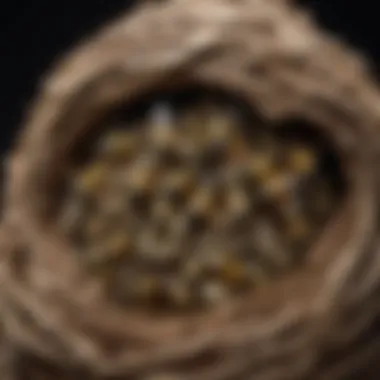
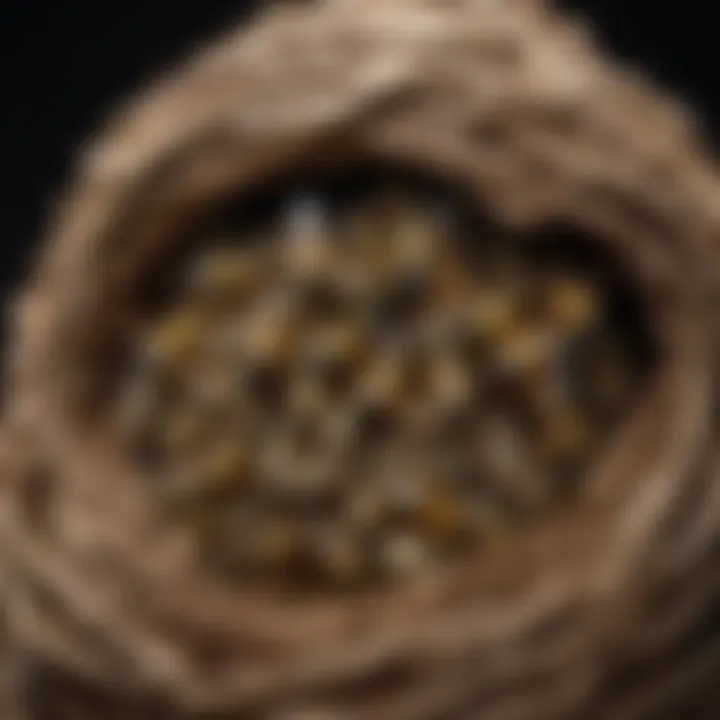
Food Source Management
Managing food sources is equally important in preventing wasps. These insects are attracted to food, especially sugary substances, which can lead them into your backyard. Here are some essential practices to consider:
- Cover Food During Outdoor Activities: When hosting outdoor events, keep food covered until it is ready to be served. Use food tents or lids to minimize exposure to wasps. Sugary drinks should also be kept sealed.
- Dispose of Waste Properly: Ensure that garbage bins are tightly sealed. Wasps are attracted to odors from food waste. By regularly cleaning and securing trash cans, you can reduce their attraction.
- Clean Up After Meals: Post-meal cleanup is essential. Making it a habit to promptly clean surfaces and remove leftovers will decrease potential food sources for pesky wasps.
Adopting these food management strategies creates a less inviting environment for wasps. With aware behavior and consistent practices, homeowners can contribute significantly to reducing wasp incidents in their backyards.
"Prevention is key. A proactive approach can make a notable difference in controlling wasp populations."
By enacting these preventions, the likelihood of an uncomfortable wasp encounter is reduced, making your outdoor living spaces more enjoyable.
Chemical Repellents for Wasps
Chemical repellents for wasps play a crucial role in integrated pest management strategies for homeowners. Understanding the advantages of these repellents is important for effectively controlling wasp populations. They provide immediate results and can create a barrier that deters wasps from entering specific areas, such as gardens or patios. Chemical solutions offer targeted action, which can be essential for those facing more severe issues with wasps.
Common Chemical Solutions
There are several chemical repellent options available. Some of the most commonly used include:
- Pyrethroids: These are synthetic chemicals that mimic natural insecticides. They effectively disrupt the nervous systems of wasps, leading to quick results.
- Boric acid: This is a less toxic option that targets wasps without being harsh on the environment. It acts gradually, poisoning the wasp over time.
- Essential oil blends: Combining certain essential oils can create a mild yet effective repellent. Oils such as peppermint, clove, and lemongrass can confuse and deter wasps when sprayed directly or used in diffusers.
- Ready-to-use sprays: Many manufacturers offer pre-mixed sprays designed specifically for wasp control. Clearly read instructions before application to ensure safety and effectiveness.
Choosing the right chemical solution depends on several factors, including the level of infestation and environmental considerations.
Safety Precautions
When using chemical repellents, safety should be a top priority. Here are some important precautions to consider:
- Read Labels Thoroughly: Always check product labels for active ingredients and usage instructions. Different products may have specific application methods.
- Protective Gear: Wear gloves, masks, and goggles while applying chemicals to avoid skin or respiratory irritation.
- Keep Away from Children and Pets: Ensure treated areas are inaccessible for children and animals until it is safe to return.
- Timing of Application: Apply chemicals during times when wasp activity is lower, typically early morning or late evening. This reduces the risk of encountering aggressive wasps.
- Disposal of Containers: Dispose of used chemical containers properly. Many chemicals can be harmful to the environment if not discarded according to guidelines.
"Safety and careful handling ensure that chemical repellents provide effective wasp control without harm to people or pets."
Natural Wasp Repellent Solutions
Natural wasp repellent solutions have gained attention for their effectiveness and safety compared to chemical alternatives. As concerns about environmental sustainability and health safety grow, many homeowners seek ways to manage wasps without resorting to synthetic substances. These solutions often utilize everyday ingredients known for their repellent properties, making them accessible and practical for home use. Additionally, natural repellents contribute to a more holistic approach to pest management, aligning with eco-conscious practices. It is essential to understand that while these methods may not guarantee complete eradication of wasps, they can significantly reduce wasp activity and discomfort in outdoor spaces.
Essential Oils as Repellents
Essential oils have become recognized for their potential to repel various pests, including wasps. Oils such as peppermint, clove, and lemongrass are often cited for their efficacy. These oils emit strong scents that are unpleasant to wasps, effectively deterring them from frequenting certain areas. For those interested in trying this approach, it is crucial to ensure proper dilution when applying to avoid skin irritation or damage to plants.
To use essential oils effectively against wasps, consider the following methods:
- Diffusion: Using an essential oil diffuser in outdoor areas can disperse scent and create an unfriendly environment for wasps.
- Sprays: A mixture of water and a few drops of essential oil can be combined in a spray bottle. This can be sprayed around entry points to homes or gatherings outdoors.
- Cotton Balls: Soaking cotton balls in essential oil and placing them in strategic locations can provide continuous repelling effects.
"Natural repellents, including essential oils, provide a sustainable approach to managing wasps without the risks associated with chemical options."
DIY Repellent Recipes
Creating your own wasp repellent at home is not only satisfying but also economical. There are simple recipes you can use to deter wasps effectively. These recipes typically rely on common household ingredients that are safe for the environment and the family.
- Peppermint Oil Spray:
- Vinegar and Dish Soap Trap:
- Citrus Oil Spray:
- Mix 2 cups of water with 10-15 drops of peppermint oil in a spray bottle. This blend can be used around picnic areas or decks to keep wasps at bay.
- Combine equal parts of vinegar and water in a bowl, adding a few drops of dish soap. The soap breaks the surface tension, allowing wasps to drown. Place this near areas of high activity.
- Mix 2 cups of water with 10 drops of citrus oil. This can be used similarly to the peppermint spray and offers a pleasant scent while keeping wasps away.
Utilizing these DIY repellent recipes can be an effective way to enhance your wasp management strategy in the yard. Regular application during peak activity seasons could maximize effectiveness and improve outdoor comfort.
Wasp Traps: A Management Tool
Wasp traps serve as a pivotal element in effectively managing wasp populations in backyard settings. They provide an immediate solution that can significantly decrease the number of these pests by luring and capturing them. For homeowners dealing with wasp infestations, understanding the different types of traps and their operational methods can make a substantial difference in maintaining a peaceful outdoor environment. Utilizing traps can be seen not only as a method of reduction but also as part of an integrated pest management strategy. This approach can minimize the reliance on chemical solutions and align with eco-friendly practices.
Types of Wasp Traps
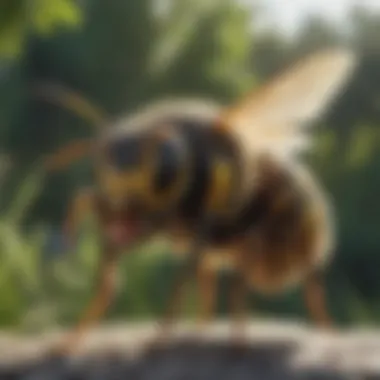

There are several types of wasp traps available, each designed with unique features to attract and capture these insects. Here are the most common types:
- Bait Traps: These utilize attractive scents or food to lure wasps. They often contain a liquid bait, like sugary solutions, which can be particularly effective in late summer when wasps are more aggressive in searching for food.
- Sticky Traps: As the name suggests, these traps are coated in a sticky substance. They capture wasps upon contact, making them a straightforward option. However, the downside is that they may not effectively reduce the wasp population but are useful for monitoring.
- DIY Traps: Homeowners can create traps using household items. For example, a plastic bottle cut in half and filled with sugar water can effectively attract wasps. This option is environmentally friendly and very low-cost.
- Commercial Traps: These are designed specifically for wasp control and come in various forms. Some may include pheromones to enhance attraction. They tend to offer a more specialized solution and often come with user instructions for optimal placement and use.
How to Use Wasp Traps Effectively
Employing wasp traps effectively requires careful placement and maintenance. Consider the following steps:
- Location: Place traps away from areas where people gather. This reduces the chances of attracting wasps too close to social spaces.
- Timing: Set traps at the beginning of the wasp season, typically in late spring. This action helps to catch wasps early, preventing nests from forming.
- Monitor and Maintain: Regularly check the traps and refresh the bait as needed. Ensure they are cleaned out if they collect non-target insects to maintain effectiveness.
- Distance from Food Sources: Position traps strategically away from known food sources, such as picnic areas. This placement keeps wasps from being drawn to other attractions instead of the traps.
- Combination with Other Methods: It is beneficial to combine trap use with other management strategies, such as habitat modification and food source management. This integrated approach enhances overall control and minimizes future infestations.
Utilizing traps as part of your wasp management strategy can significantly reduce the population and create a more enjoyable outdoor space for your family.
Following these guidelines will not only improve the efficiency of the traps but also contribute to a sustainable approach to wasp management in your backyard.
Working with Professionals
Engaging with pest control professionals can offer numerous advantages when dealing with wasp infestations. While many homeowners attempt to manage pests using DIY methods, there are practical reasons to consider professional intervention. The most significant benefit is that experts bring a wealth of knowledge and experience that is often lacking in lay methods. Understanding wasp behavior and nest structure is crucial to effective control strategies, and professionals are trained to handle these pests safely and efficiently.
When faced with a wasp problem, it can be unclear whether a DIY approach will suffice or whether it is time to employ expert services. Seeking assistance from pest control does not only concern the scale of infestation but also addresses safety considerations. Wasps can pose health risks, especially for individuals allergic to their stings. Professional pest control teams have the appropriate gear and techniques to handle wasps with minimal risk, making their interventions more desirable for the safety of all.
"Knowledge and expertise in dealing with wasps can save a great deal of time and potential danger."
Additionally, trained professionals often use environmentally responsible methods that comply with local laws and regulations regarding pest control. This becomes particularly significant in areas where chemical usage is restricted. By choosing a professional service, homeowners can ensure that their pest control efforts align with legal requirements. Moreover, professionals can offer long-term solutions by identifying contributing factors that attract wasps. They can also provide guidance to prevent future infestations, which is crucial for maintaining a peaceful backyard environment.
When to Call Pest Control
Determining the right moment to call pest control can be challenging. However, several indicators suggest when professional help is imperative.
- Assessment of Infestation: If you observe a nest forming and wasp activity increasing, it may indicate that your backyard has become an attractive habitat for these pests. If you feel uncertain about the extent of the infestation, experts can provide a thorough assessment.
- Safety Concerns: If anyone in your household has a severe allergy to wasp stings, it is crucial to avoid any risks. Contacting professionals ensures that the issue is handled safely.
- Difficulty in Control: If previous attempts to manage wasps with home remedies or traps have failed, this is a clear sign that a more skilled approach is needed.
Choosing the Right Pest Control Service
Selecting an appropriate pest control service involves more than just a quick online search. It requires careful consideration to ensure you choose a provider that meets your needs effectively.
- Check Credentials: Verify that the company is licensed and insured. This ensures they comply with regulatory standards and provides you a point of recourse if needed.
- Read Reviews: Look for customer feedback and testimonials on platforms such as Facebook or Reddit. This can provide insight into the company's reliability and customer service.
- Inquire About Methods: Ask potential services about their pest control methods, particularly if you have a preference for natural or eco-friendly solutions. This dialogue will clarify whether their practices align with your values raised in this guide.
Legal and Safety Considerations
In managing wasps in the backyard, understanding the legal and safety considerations is crucial. Proper knowledge about regulations and safety measures protects not only yourself but also the environment. Ignoring these aspects can result in legal issues or unsafe situations that might compromise your well-being and that of others.
Regulations on Chemical Use
When using chemical repellents or pesticides, it's important to be aware of local regulations. Different regions have specific laws governing the use of chemicals, especially in residential areas. Commonly, these regulations include guidelines on:
- Permissible Chemicals: Some chemicals may be banned or restricted due to environmental concerns or health risks. Always check if the product is approved for use in your area.
- Application Methods: There may be rules regarding how, when, and where chemicals can be applied. For instance, some areas may restrict their use during certain months to protect pollinators.
- Disposal Regulations: Proper disposal of chemical containers and residues is vital to prevent contamination of soil and water sources. Follow local authorities' disposal guidelines to ensure compliance.
"Always consult local environmental agencies or pest control services for updated information on regulations regarding chemical use."
Taking the time to understand these regulations helps maintain legal compliance while ensuring effective wasp management. It is advisable to read product labels thoroughly before application. This awareness not only protects your household but promotes community safety as well.
Allergy Precautions
Wasps pose a significant risk to individuals with allergies, especially those known to be sensitive to insect stings. Homeowners must be aware of these hazards when implementing wasp management strategies. Here are some precautions to consider:
- Understanding Allergies: Knowing whether you or your family members are allergic to wasp stings is fundamental. An allergic reaction could include severe symptoms requiring immediate medical attention.
- Informing Others: If you have visitors, informing them about the presence of wasps and the associated risks can help ensure their safety.
- Emergency Preparedness: Keep an emergency plan ready, including access to an epinephrine auto-injector for those known to have severe reactions.
- Controlled Response: When dealing with wasps, consider non-invasive methods or natural repellents initially. If a chemical solution is necessary, proceed with caution and follow all safety instructions closely.
Maintaining awareness about wasp allergies not only protects individuals but also fosters a safer environment for everyone. Proactive safety measures create a more comfortable outdoor experience for all residents.
Future Trends in Wasp Control
Understanding future trends in wasp control is essential for homeowners seeking to maintain a harmonious environmental balance. As concerns about the ecological impact of pest control methods grow, innovations and sustainable strategies are becoming increasingly relevant. These trends not only enhance effectiveness but also prioritize safety for humans, pets, and beneficial insects. The integration of technology and eco-conscious choices plays a pivotal role in shaping new management practices.
Innovations in Pest Management
Recent developments in pest management technology are changing how we approach wasp control. One significant innovation includes the use of smart traps equipped with sensors that notify homeowners of wasp activity. This allows for precise monitoring, making it easier to deploy solutions when necessary. Additionally, advancements in pheromone-based attractants are becoming popular. These can be used in traps to lure wasps without chemical repellents, minimizing environmental impact.
Drones are also emerging as useful tools for identifying wasp nests in hard-to-reach areas. They provide a bird’s-eye view, allowing for effective assessment without disturbing natural habitats. Moreover, studies are being conducted on utilizing naturally occurring bacteria and fungi as biopesticides. Unlike traditional chemical pesticides, these biological agents are less harmful to the ecosystem and target specific pests. Incorporating such innovations ensures robust control methods while respecting ecological integrity.
Sustainable Approaches to Wasp Control
As the demand for sustainable pest management grows, many homeowners are now exploring eco-friendly alternatives to traditional methods. One promising approach is the enhancement of natural habitats that support wasp predators. For example, creating environments that attract birds and other insects that feed on wasps can help control their population naturally. This method promotes biodiversity and supports the overall health of the ecosystem.
Integrating organic solutions, such as the use of essential oils and plant-based repellents, is another sustainable strategy gaining traction. These options provide effective wasp deterrence without resorting to harsh chemicals. Furthermore, home composting and responsible waste disposal practices can mitigate the food sources that attract wasps in the first place. Such practices contribute not only to wasp control but also to environmental conservation.







